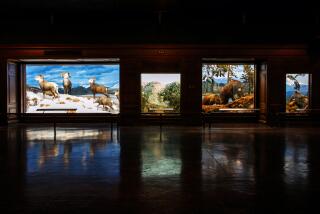Planet Earth: a life story
- Share via
Earth
An Intimate History
Richard Fortey
Alfred A. Knopf, 430 pp., $30
*
Standing on a narrow footpath high in the Alps, Richard Fortey invites us in “Earth: An Intimate History” first to take in the visible scene, then to visualize the vaster picture of which it is a part:
“[W]e can see the Mediterranean Sea with its pattern of islands, and the great boot of Italy hanging downwards. We might even make out a plume of smoke from one of the classic volcanoes.... We can now appreciate the whole sweep of the Alps, and its continuation eastwards into the great arc of the Carpathian Mountains, and beyond that into Turkey, where we know the ground still shakes disastrously when the earth shrugs. We can comprehend that this is all one interconnected system.... Then we see Africa.... If Africa is moving northwards -- and it is -- it suddenly seems plausible that all those monstrous rucks and buckled limestones and squeezed gneisses, over which our insignificant bodies clambered in the Alps, might be no more than the desperate scrambling of the earth away from the encroachment of the inescapable giant.”
A senior paleontologist at the Natural History Museum in London, Fortey is a writer with a gift for making natural history come alive. In his earlier books “Life: A Natural History of the First Four Billion Years of Life on Earth” and “Trilobite: Eyewitness to Evolution,” he focused on the story of Earth’s living things and their evolution.
Now, with his new book, he turns his attention to the inanimate -- but far from motionless -- realm of Earth itself: mountains, islands and continents; volcanoes and earthquakes; and the restless tectonic plates that create them.
Although the title seems to promise a chronological narrative of our planet’s estimated 4 1/2 -billion-year history, Fortey has taken a different tack, approaching his subject geographically rather than sequentially. He begins with Mount Vesuvius, the volcano that destroyed Pompeii, and then transports us to the volcanically created islands of Hawaii.
Subsequently, we visit other locales, including the Swiss Alps, the Appalachians, the Deccan Traps of India, Newfoundland, Scotland, Iceland, the Grand Canyon, the Mojave Desert and Los Angeles. Indeed, at times the book reads almost like a collection of travel pieces, except that Fortey doesn’t just describe the scene: He goes beneath the surface to explain the forces that continue to shape the landscape.
Intermingled with all this are portraits of pioneering geologists and their theories, disquisitions on topics such as mining and mineralogy, and wonderfully apt literary quotations that bespeak a genuine erudition. Alpine meadows put Fortey in mind of D.H. Lawrence’s dark blue “Bavarian Gentians”; underground crystallization chambers summon up lines from Keats: “A dusky empire and its diadems; / One faint eternal eventide of gems.” And the fact that mountains have been thrust up to their heights from the sea-floor inspires him to cite Scottish poet Hugh McDiarmid:
We must be humble. We are so easily baffled by appearances
And do not realise that these stones are one with the stars.
It makes no difference to them whether they are high or low,
Mountain peak or ocean floor, palace or pigsty.
There are plenty of ruined buildings in the world but no ruined stones.
The book is crammed with interesting material, vividly and colorfully conveyed. If carbon and its organic compounds are the building blocks of life, carbon’s close relative silicon, as Fortey explains, plays a similar role in the mineral world. Silicon and oxygen combine to create quartz, which can take the form of humble sand, beautiful rock crystal or, tinted by traces of other elements, gemstones such as amethyst and carnelian. Fortey reminds us that beauty, like usefulness, is not necessarily related to rarity: “The quartz minerals that produce them are usually described as ‘semi-precious,’ but they are in no sense semi-beautiful.”
But the true “protagonists” of this story are the ever-shifting tectonic plates, pushing up mountains, setting off earthquakes and volcanoes, creating islands and putting continents on the march. They are not, alas, very “likeable” protagonists (especially to us in California), and the story in which they star is an unsettling one. The book’s main problem, however, is the way in which the material is organized. There seems no particular order to Fortey’s approach, and the saga of Earth’s history -- the “big picture” -- is obscured by the sheer number of details. This not only hampers our ability to understand the geological processes but also deprives the book of narrative drive, making it difficult to read straight through. Nonetheless, it’s a delightful book to dip into, a treasure-house of mind-expanding lore.
Merle Rubin is a contributing writer to Book Review.
More to Read
Sign up for our Book Club newsletter
Get the latest news, events and more from the Los Angeles Times Book Club, and help us get L.A. reading and talking.
You may occasionally receive promotional content from the Los Angeles Times.









